Icy Inverts Cruise 2013 - Shipboard Blog - Jan 30th to Feb 2nd
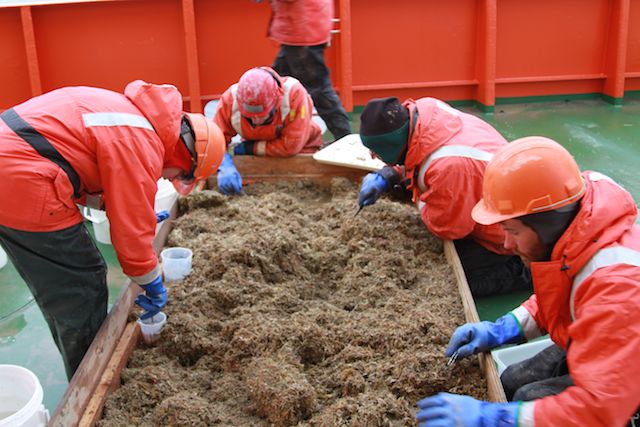
02 Febuary 2013: in the Eastern Ross Sea (76o 29.1`W, 165o 43.1`S)
I’m Awake!!
We have started sampling fast and frequently in the Ross Sea. We started yesterday? It’s hard to keep track of days/time with all of the changes and no nightfall. We conduct all of the science events that others have already described in the blog, and then immediately begin transiting to the next sampling point - so work flow is pretty constant. The major difference we’ve seen between the Ross Sea and our previous sampling areas is the amount of biomass in the trawls. The trawls here in the Ross look like giant piles of grass clippings when we deposit them in the sorting box (above picture). Previously, we were getting either mud packed with organisms or pretty clean trawls with lots of animals and some gravel. The ‘clippings’ are filled with bryozoans and sponges as well as the other animals we’re used to seeing, but the sheer quantity of sponges and bryozoans makes the sorting and processing a challenge. Sponges act as microhabitats and many organisms make them their home. We are interested in those animals as well as larger ones and have to pick through the sponges and other matter to find everything. Kind of like the proverbial ‘needle in the haystack’.
My main responsibility on the ship has been as a Multi-Beam technician which involves using sonar to map the sea floor we are sampling. In our previous locations in the Bellingshausen and Amundsen Seas, we found a lot of iceberg scours. These are areas scraped by icebergs that have broken free from the glaciers. We have not seen as much evidence of recent scours in the areas we’re sampling in the Ross and surmise that we are seeing areas that have had more time for sponges and bryozoans to grow undisturbed. It might be an example of later succession. We see this frequently on land when areas that have been logged or turned into fields are left to return to their natural state. Initially, smaller and sparser vegetation dominates but as time progresses larger more dense vegetation appears until you have a large forest again. It’s possible that this type of succession might be what we are witnessing here.
Only one week left onboard. It’s going to be a very busy week but we are getting great samples which will be the basis for some very relevant science. So definitely worth the effort.
Infinite Diversity in Infinite Combinations,
Contributed by: David Branson, Ph.D. Candidate – Marine Molecular Ecology, Auburn University
***************************************************************************************
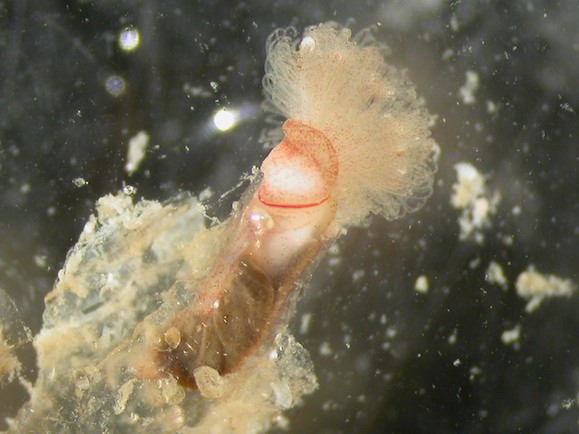
1 Febuary 2013: In the Ross Sea (76o 23.9`S, 170o 57.9`W)
Good day from the Ross Sea!
Here on the Palmer, we’ve begun greeting each other with “good day”, rather than “good morning”, “good afternoon”, or “good night”, because we’re all on differing schedules, and at any time of day or night, it may be that someone has just woken up! And with no darkness 24/7, a wish of “good day” always seems appropriate. So good day to all of you who have been following our adventure!
As we begin our sampling in the Ross Sea, I’ll be eagerly peering into the mass of organisms and mud that arrives on deck with each trawl, looking for the telltale signs that my favorite creatures, the enigmatic and unusual pterobranch hemichordates, are there. These animals are soft-bodied, only a few millimeters long (above picture), often brown in color, and are extremely delicate. How can I possibly find such small and fragile creatures in a huge trough of mud? Luckily for them and for me, these animals are remarkable builders, and construct elaborate housing systems for themselves out of secreted proteins and collagen (below picture). Although each individual animal may be only a few millimeters long, their houses can be over a foot high, and are inhabited by colonies of hundreds of the tiny creatures. It is these houses, called coenecia, that I’ll be looking to find in the trawls.
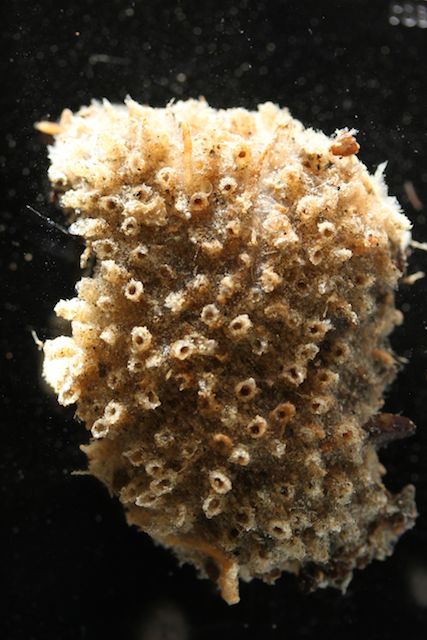
These colonial pterobranchs are members of phylum Hemichordata, which has been the focus of my dissertation research at Auburn University (below picture). Although you might not guess it at first glance, these animals actually share some interesting features with chordates, the phylum that includes humans. By looking closely, scientists have discovered that hemichordates have structural and developmental similarities to chordates, and these animals have been key to many hypotheses about chordate evolution. About half of all pterobranch species are found here, in the Antarctic and Sub-Antarctic. Because they are difficult to collect and are rarely encountered outside of Antarctica, there is much that is not understood about the way these animals live. We’ve already found two species in the Amundsen Sea, but the Ross Sea has a greater historical record of pterobranch collections, so we may be lucky and find many more here. I’m hoping to collect as many different species as possible, and help to unlock some of the mysteries surrounding this bizarre group of animals.
Contributed by: Joie Cannon, Ph.D Candidate, Auburn University
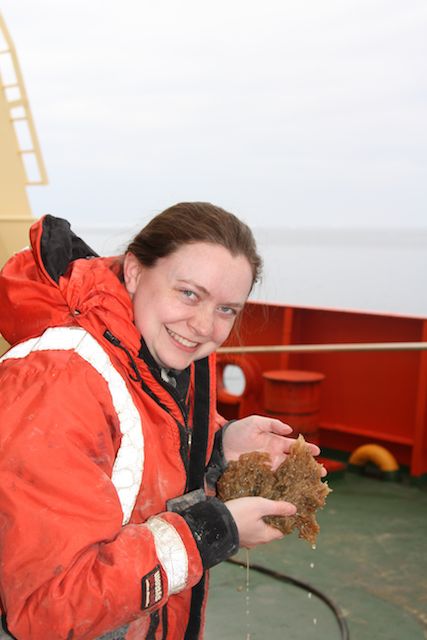
***************************************************************************************
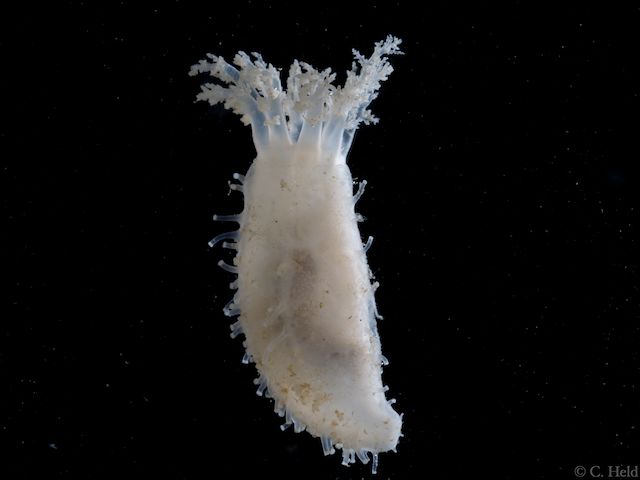
31 January 2013: Northeastern Ross Sea (74° 29.0`S, 175° 9.0`W)
We are still breaking ice on our way to the first station in the Ross Sea, time to get organized. All the samples we collected previously are now properly organized, the “book” of all samples is up to date, the freezer and refrigerators have been emptied as far as possible - a rare sight in the course of the sample taking frenzy the last weeks have been.
My main research interests are centered around crustaceans but I have also been wearing my photographic documentation hat a lot during this expedition. Although I have working on Antarctic topics for almost two decades now, I never cease to be amazed at the morphological diversity and beauty of the organisms we haul to the surface (such as the sea cucumber in the above picture), some of them never seen before. Much of their beauty seems to be lost in so many ways, at the depth of more than 400 meters where we are typically trawling no sunlight reaches to illuminate their sometimes extravagant ornamentation, when the samples come on deck there is no time appreciate any of it and even the most beautiful specimens are always covered in mud and bits of other things, many marine organisms collapse when not in water, etc.
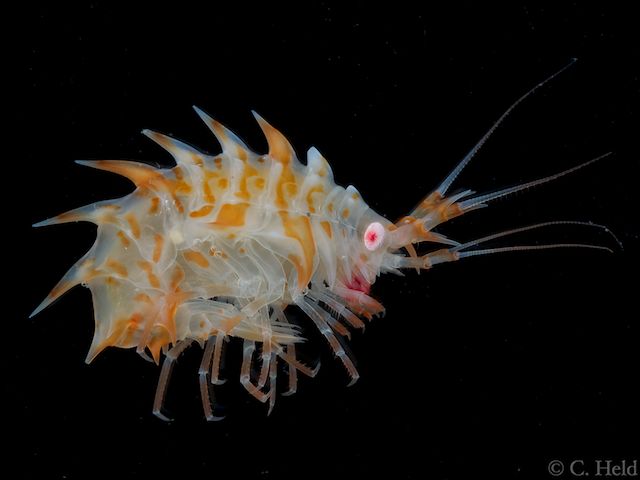
But when I am done sorting the crustaceans (such as the amphipod in the above picture), I turn to the other bucket of cold seawater containing unharmed specimens I have aside for the purpose of restoring their natural beauty and taking photographs. For this they have to be alive and in water, which makes them hold still for long enough to focus a daunting task already. When the whole frame measures only a few centimeters and the depth of field only millimeters or fractions of millimeters, even the polychaete worm that seemed almost immobile in the bucket suddenly becomes a fast mover in the photo aquarium. Add the movement of the ship that make even perfectly motionless animals swing by what the camera is seeing for moments only and you get an appreciation of the difficulties. Getting a good picture is often anticipating where it will be rather than where it is now - no job for short tempered people. The lighting needs a lot of care as well, what works for one species of amphipods does not necessarily look good for scale worms. The reason why I am taking these pictures is twofold: When we get to see the animals we caught back home in the lab, they will have bleached out and turned into an off-white colour but on the pictures we can still see that they can be easily distinguished by their sometimes vivid colouration (such as those of this crinoid in the below picture). And a picture tells much more than a thousand words for outreach purposes.
Don’t get me wrong, I love icebergs, seals and penguins, but I hope my pictures will help create more awareness for smaller marine creatures that may be harder to see but equally important and beautiful as the more traditional icons of Antarctic wildlife.
Contributed by: Dr. Christoph Held, Senior Researcher, Alfred Wegener Institute for Polar and Marine Research, Germany
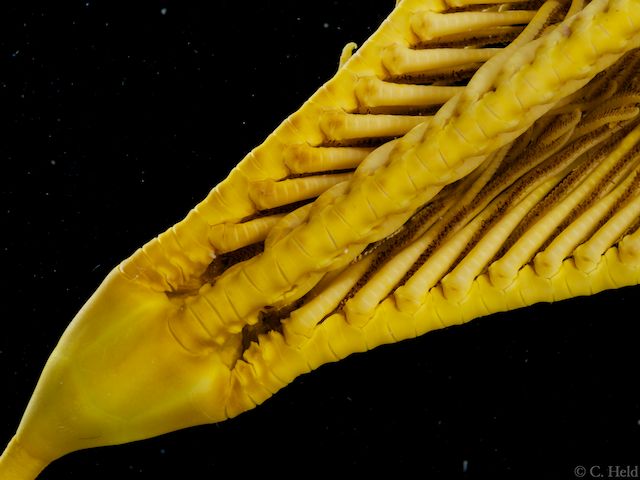
***************************************************************************************
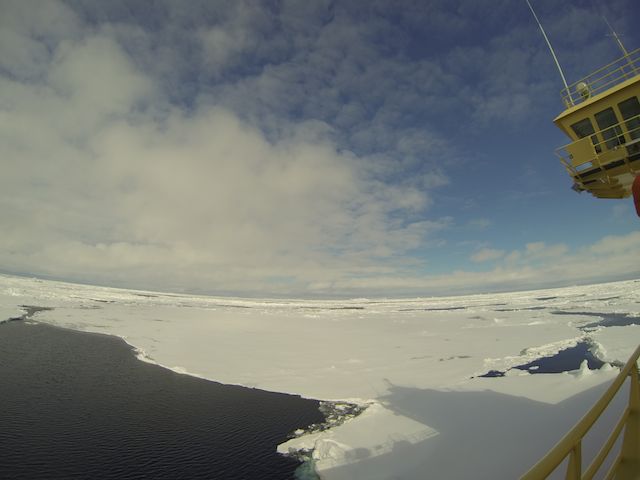
30 January 2013: North of Ross Sea (73o 20.9`S, 172o 01.6`W)
We are finishing our last major transit of the trip and will be in the Ross Sea proper very soon. This is sorta ‘under’ New Zealand. Although we are in transit, there is still a lot of activity on board. For starters, since leaving Punta Arenas we have been turning our clock back an hour every few days to account for the fact that we are sailing further west. Well now we are very close to the International Date Line where West meets East. As a result we turned our clocks, not back this time, but forward one whole day. For us on the R/V Palmer, 29 Jan consisted of 1 whole minute till 12:01 AM before we time traveled forward one day (this would make Dr. Who proud).
While we heading into the Ross Sea, we have comeback into ice and icebergs. One might think all sea ice looks alike, but amazingly it does not. So far most of the sea ice we have encountered has been first year ice, meaning it froze and formed last winter. Such ice tends to be flat and with out much ice piled on top of itself (above picture). However, now we are also starting to see some thicker flows that are multiyear ice. These are ice flows that formed a few winters ago and were substantial enough to survive several Antarctic summers. Ah summer….warm temperatures. One other noticeable change has been the temperature, currently it is snowing, the temp is about -3 degrees C and the wind chill is substantially colder (-20 to -25 degrees C). The ‘constitutional’ breaks many have been enjoying on the bow of the ship watching for penguins, seals and whales, have become noticeably shorter because of the cold.
Importantly, while we have some travel time, we have been preparing for wrapping up our cruise. Even though we have a full week of sampling in front of us, we literally have thousands of samples stored in ethanol and in the freezer that need to be packed according to transportation regulations, including entering spreadsheets of the samples in hand. This process has taken the better part of two days. Once we dock in McMurdo we will have just a few short hours to offload our samples, our gear, and ourselves. Thus, as much as possible needs to be ready to offload. The samples will be flown out of McMurdo Station to New Zealand, like us, and then on to California before arriving at our home institutions.
The transit and entering of data has also given us time to reflect upon the organisms we have obtained. The diversity of species we have recovered in such cold waters is incredible. We no doubt have collected many species that were previously unknown. In discussions over dinner or at science meetings, we are constantly talking about the “funny looking worm” or the “isopod with a funny looking tail”. On the ship, we are fortunate to have scientists whose collective knowledge of invertebrate organism (and Antarctic organisms) is quiet amazing. Yet there have still be a few animals that have totally stumped our collective ability. For example, we have found one parasitic organism that is so highly modified that we cannot even tell what phylum it belongs to!! One other guessing game we have played has been as a result of the Yo-Yo Cam. This is a camera that we tow deep in the water to collect images of the sea bottom. The below picture includes sponges, soft corals, brittle stars, moss animals, and more. Can you find them all (below picture)? The camera gives a top down view of the animals and so one needs be able to picture animals from different angles in their ‘minds eye’. This is what makes these scientific expeditions, and science in general, so much fun…..figuring out the unknown!!!
Contributed by: Dr. Ken Halanych, Chief Scientist, Schneller Endowed Chair, Auburn University
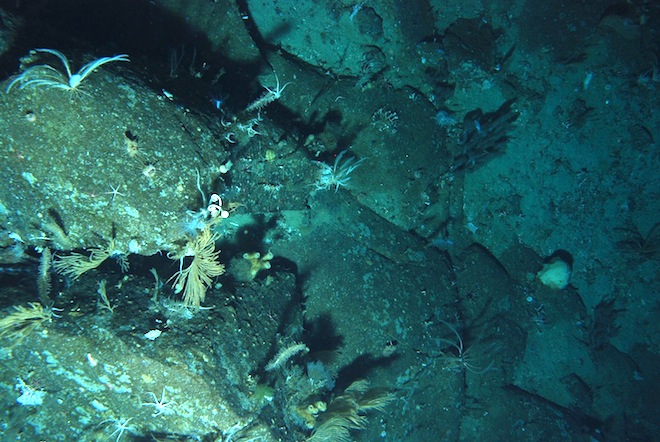
Last updated: 11/12/2013
